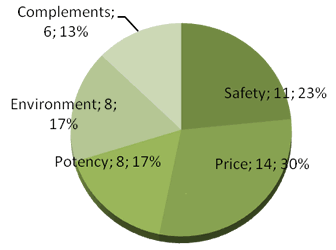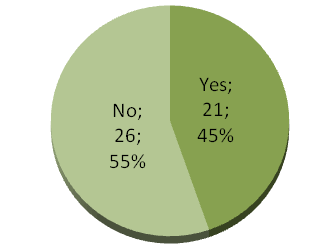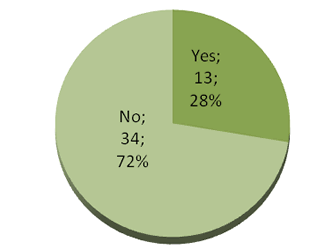|
OBJECTIVE OF THE SURVEY
The purpose of this survey is to analyse the acceptance of the car powered with alternative energies by the potential consumer collective, as well as the predisposition of this group to purchase it. At the same time, the grade of difficulty that this new kind of vehicle could have in its implantation is evaluated.
Another objective is to scope out the interest of the average people on the environment when they decide to buy a car and the characteristics in a vehicle which influence the most in their decision.
QUESTIONS
1) If you should buy a car, which would be your main criterion of election to choose it?
Possible answers:
• Safety
• Price
• Potency
• Environment
• Complements
2) Do you know the cars that work with alternative energies?
Possible answers:
• Yes
• No
3) Would you acquire, in the midterm, one of these vehicles although they might offer less autonomy and they would be more expensive than the usual ones?
Possible answers:
• Yes
• No
4) Have you got any relative or companion who owns one of those vehicles?
Possible answers:
• Yes
• No
ABOUT THE SAMPLE
This survey was realized at 16 th May, 2009 in the Saló de l'Automòbil de Barcelona . The sample is formed by visitors of that fair who had been randomly chosen. This method was followed in order to obtain the profile of the average potential car buyer.
WOMEN |
20-30 |
30-40 |
40-50 |
50-60 |
Total |
ESO |
0 |
0 |
1 |
0 |
1 |
FP1 |
0 |
0 |
1 |
0 |
1 |
FP2 |
1 |
3 |
0 |
0 |
4 |
University |
2 |
2 |
0 |
0 |
4 |
Total |
3 |
5 |
2 |
0 |
10 |
MEN |
20-30 |
30-40 |
40-50 |
50-60 |
Total |
ESO |
0 |
1 |
2 |
1 |
4 |
FP1 |
1 |
2 |
2 |
2 |
7 |
FP2 |
5 |
7 |
5 |
2 |
19 |
University |
2 |
3 |
2 |
0 |
7 |
Total |
9 |
13 |
11 |
5 |
37 |
The resultant numbers show that men are, by far, the most interested gender in the automotive world, in the same way as in acquiring a vehicle. They also insinuate that, inside this collective, the most potential car buyers are men from thirteen to fifty years old, no matter what their wealth or study level is, who are supposed to be workers with family and a safe monetary income.
In the case of the women, it is noticeable that this collective is more prone to purchase one in the age between thirty and forty years old, but also around twenty-five. That appears to be because females with those ages are usually workers with need of commuting to their job. However, due to the social cliché what define men as the dominating sex in this issue, women play a much tighter role in the car market.
RESULTS
1) If you should buy a car, which would be your main criterion of election to choose it?
|
Num. |
% |
Safety |
11 |
23 |
Price |
14 |
30 |
Potency |
8 |
17 |
Environment |
8 |
17 |
Complements |
6 |
13 |
|
|
 |
CONCLUSION:
It is logic that nowadays, in an economic crisis context, the price of the car takes the greatest relevance in the customer's decision due to the decline of the middle class purchasing capacity. However, safety is still a very important factor for the buyer, who isn't always likely to buy a less safe car in order to save money.
According to the results, the environment protection is an aspect that, if it is not the less valued, it is not too relevant in percentage, because less than two persons of each ten would have it as one of their main criterions. This is a demonstration of the lack of environmental awareness of the society, a fact that can make the introduction of alternative fuels implausible in the middle term.
2) Do you know the cars that work with alternative energies?
| |
|
Num. |
% |
Yes |
21 |
45 |
No |
26 |
55 |
|
 |
CONCLUSION:
A fifty-five percent of people who recognise that they ignore the existing sorts of alternative-fuelled vehicles (considering that they are persons with a supposed higher knowledge about the automotive world) does not just mean a scarcity of divulgation about this theme, but also a significant disinterestedness by this collective towards it.
3) Would you acquire, in the midterm, one of these vehicles although they might offer less autonomy and they would be more expensive than the usual ones?
|
Num. |
% |
Yes |
13 |
28 |
No |
34 |
72 |
|
|
 |
CONCLUSION:
Although the general pessimism towards the alternative car technologies that results show (nearby three of each four surveyed people would not buy one), a twenty-eight percent of positive answers mean that, as a minimum, there is a profile of customers disposed to rely in new kinds of energies and, by the way, help to introduce them in the traffic network.
Nevertheless, nearby all the surveyed people commented that the absence of facilities to fuel those cars along with their elevated prices are great handicaps of these alternative technologies. This fact means that the same people who said yes could change their opinion if, in the middle or long term, there was not an investment on facilities to allow their operation, so the consumers would never see the right opportunity to achieve the vehicle.
4) Have you got any relative or companion who owns one of those vehicles?
CONCLUSION:
These numbers are an undeniable analysis of the barely noticeable role that the alternative-fuelled vehicles have in the actual private transport system. Probably, it would be hard to find a single person that could affirm this question in a random-made survey like this, since the actual percentage can be equal or inferior to the 1%.
|



